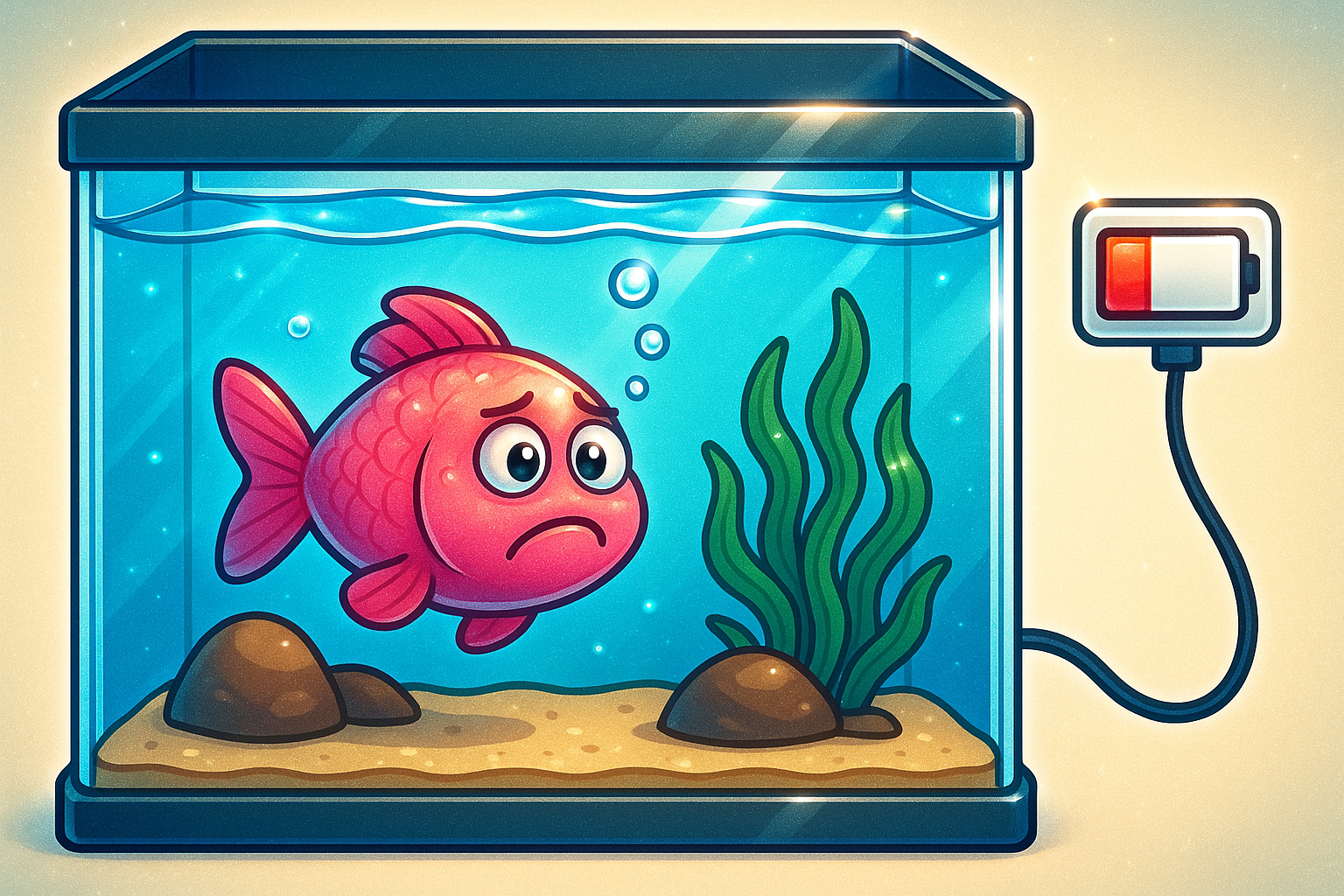Aquarium Power Outage Survival Guide
⚡🐟 Aquarium Power Outage Survival Guide
🧭 Why It Matters
When power goes out:
- ❌ Filtration stops
- ❌ Aeration stops
- ❌ Circulation stops
- ❌ Heating/cooling stops
Fish rely on dissolved oxygen (DO). Without replenishment, DO can crash to lethal levels in just a few hours depending on biomass, temperature, and backup aeration.
🧮 Core Formula (simple, effective)
Hours to Critical DO ≈
Fish demand+Microbial demand−Air supply(DO0−DOcrit)×VWhere:
- 🪣 V = tank/system volume (L)
- 🌊 DO₀ = starting DO (mg/L)
- ⚠️ DO_crit = danger threshold (~3 mg/L)
- 🐟 Fish demand = biomass (kg) × ~200 mg O₂/kg/h (species & temp dependent)
- 🧫 Microbial demand = detritus bacteria load (0.01–0.05 mg/L/h)
- 🌱 Plant net = +0.02 mg/L/h day, −0.02 mg/L/h night
- 💨 Air supply = battery pump O₂ (~150–600 mg/h per unit)
📊 Survival Time Examples (400 L system, 2.5 kg plecos at 28 °C)
| Scenario | Backup | Hours to Critical DO |
|---|---|---|
| 🐟 Heavy load (night) | ❌ No air | ~3.1 h |
| 🐟 Heavy load | 🔋 Small battery pump (~250 mg/h) | ~4.7–5.0 h |
| 🐟 Heavy load | 🔋💨 Strong battery air (~500 mg/h) | ~8 h |
| 🐟 Heavy load | 🔌 Generator (full aeration/filtration) | Indefinite |
👉 Light stocking with plants in daylight can last >10 h.
🧷 Backup Tools
- 🔋 Battery air pumps (2–3 small pumps better than 1 big)
- 🔌 Portable generator (best long-term solution)
- 🔋 USB power banks (with DC air pumps)
- 🧊 Sealed ice bottles (cool water → more O₂ + slower metabolism)
- 🪪 Spare D-cells or car inverter for emergencies
🌡️ How to Extend Survival
- ❄️ Cool water 1–2 °C → more O₂, slower respiration (+20–30% time)
- 💧 Stop feeding → less fish + microbial demand
- 🧹 Remove detritus → lower microbial load
- 🌊 Maximize gas exchange → lids off, surface turbulence
- 🐠 Reduce biomass load → move big/active fish if needed
- 🌿 Daytime vs Night: plants produce O₂ by day but consume it at night
📈 Rule-of-Thumb Reference
- 🐟 200 mg O₂/kg/h = average fish respiration at warm temps
- 🌡️ DO saturation at 28 °C ≈ 7.6 mg/L
- 🧫 Dirty tanks (microbial demand 0.05 mg/L/h) crash faster
- ⚠️ Sensitive species: use 4.0 mg/L as critical DO instead of 3.0
✅ Emergency Checklist
- 🔋 Test battery air pump(s) monthly
- 🧊 Keep ice bottles in freezer
- 🧪 Keep Seachem Prime/Safe for ammonia detox (filtration stalls)
- 🪪 Have spare D-cells / USB packs ready
- 📊 Record stocking biomass & tank volume so you know your “window”
📂 Tools for You
I prepared an Excel calculator to model your own tanks (volume, fish load, DO, air pumps).
👉 Download the Estimator
⚡🐠 Bottom Line:
At heavy stocking, you may have only 3–5 hours without backup air.
A strong battery pump doubles or triples that window, while a generator makes survival indefinite.

Powered by Lightspeed
Display prices in:USD